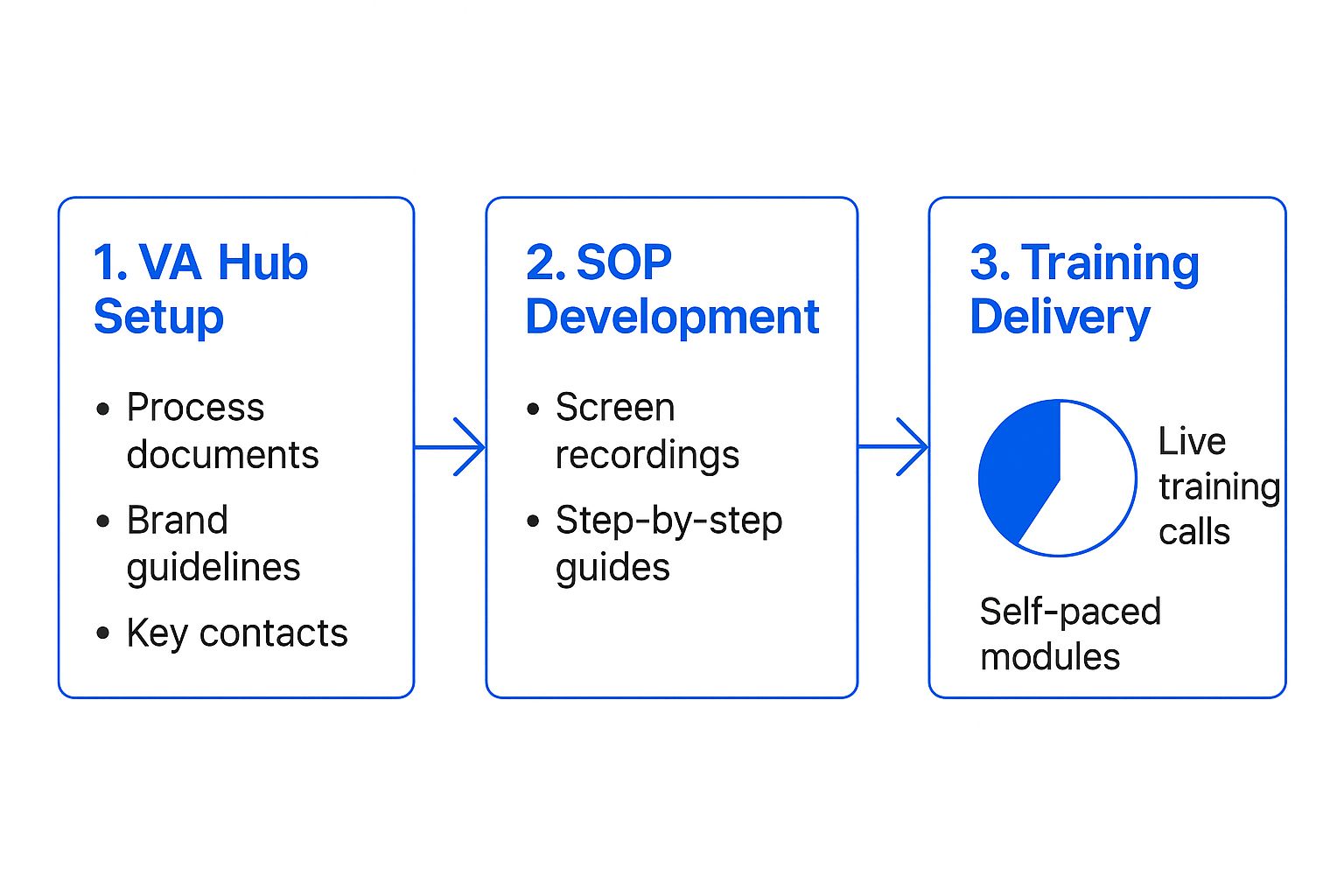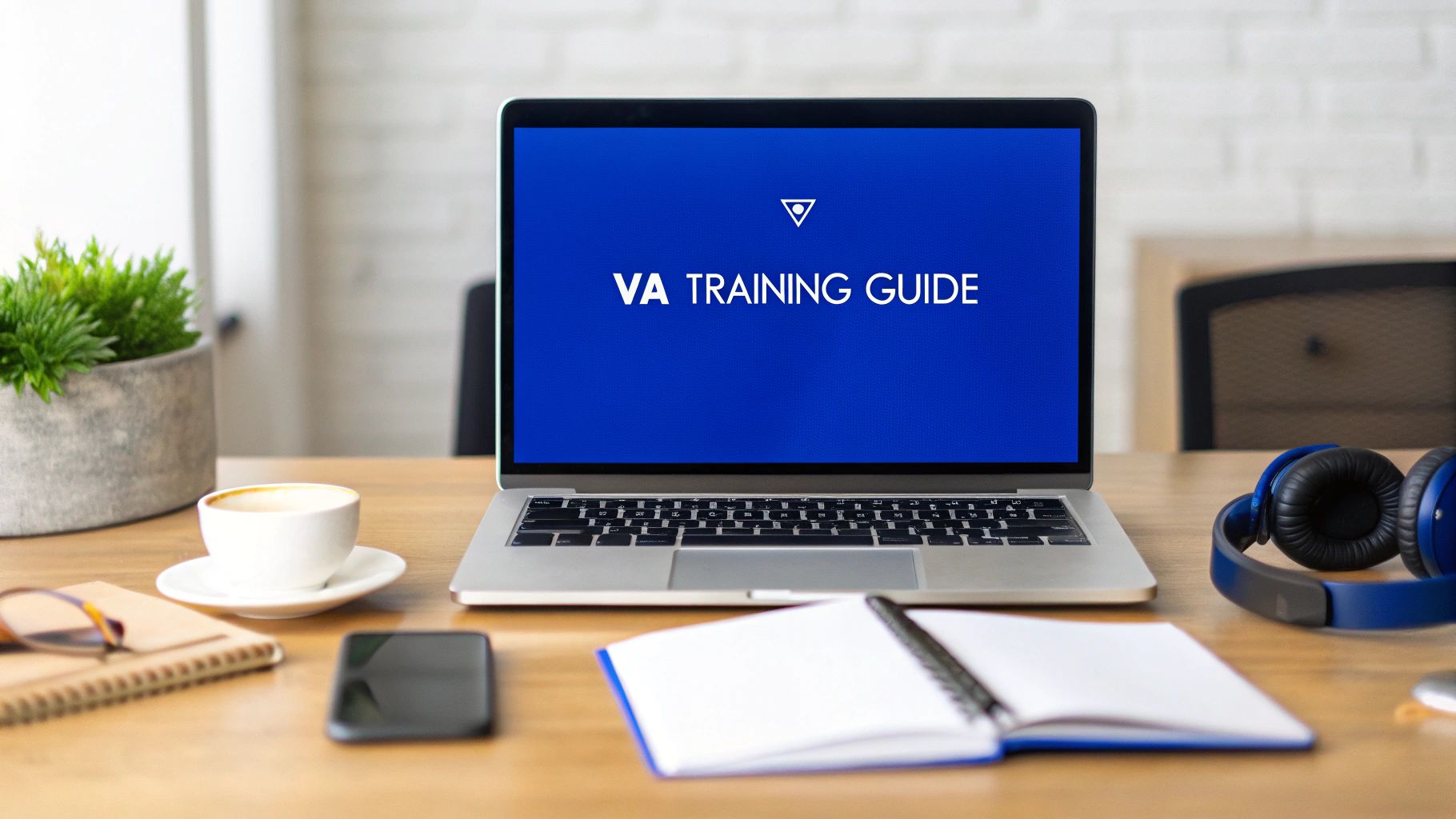Properly training a virtual assistant is much more than just firing off a list of tasks and hoping for the best. The real secret to a successful partnership starts long before you delegate that first job. It all comes down to thoughtful preparation, which sets the foundation to prevent future headaches and truly empower your new team member.
Setting the Stage for a Successful Partnership

I've seen so many businesses rush into hiring a VA. They treat it like a quick transaction—find someone, send an email with a few instructions, and cross their fingers. Unsurprisingly, this almost always ends in miscommunication, sloppy work, and frustration on both sides.
The key is to shift your mindset entirely. You're not just offloading tasks; you're bringing a new professional into your business ecosystem. This means you need a deliberate, well-planned preparation phase before they even log on for their first day. To make sure your VA thrives from the start, it helps to build your onboarding around proven virtual training strategies.
Get Crystal Clear on Roles and Responsibilities
A generic job description is a recipe for disaster. Vague instructions are the number one reason for disappointing results, so your first job is to spell out exactly what success looks like for every single responsibility.
Don’t just say, "Manage my social media." Instead, break it down into concrete, measurable outcomes.
- Content Creation: You'll be expected to draft three engaging posts for Instagram each week using our brand templates in Canva.
- Community Management: Please respond to all comments and DMs on our Facebook and LinkedIn pages within four business hours.
- Performance Tracking: By the 5th of every month, I'll need a report on follower growth, engagement rates, and our top-performing content.
This level of detail leaves no room for guesswork. It gives your VA a clear road map, so they understand not just what they need to do, but the standard you expect.
Sort Out System Access and Security Before Day One
Nothing kills momentum faster than a new VA who can't access the tools they need to work. A chaotic first day spent chasing logins sends a terrible first impression and wastes everyone's time. Before they start, get everything ready.
A well-organised onboarding process is a direct reflection of your company's efficiency. A smooth start signals to your VA that you are professional, prepared, and value their time, setting a positive tone for the entire working relationship.
I strongly recommend using a password manager like LastPass or 1Password. It allows you to grant secure access without ever handing over your master passwords. Run through a checklist to make sure you haven't missed anything:
- Project Management: Asana, Trello, or Monday.com
- Communication: Slack or Microsoft Teams
- Core Systems: Google Workspace or Outlook for email and calendars
- File Storage: Google Drive, Dropbox, or SharePoint
- Specialised Tools: Canva, Xero, specific scheduling software, etc.
Explain Your Company Culture and How You Communicate
Your VA might be remote, but they're still a part of the team. For them to really click with your business, they need to understand the unwritten rules and the general vibe. Are you a formal, "Good morning, everyone" kind of workplace, or is a quick "hey" in Slack the norm?
Document your expectations. Let them know your preferred channels for different things—for instance, Slack is for quick questions, but email is for detailed project briefs that need a paper trail. By setting these ground rules from the outset, you build a comfortable and efficient working environment where your VA feels like a true part of the team, not just a hired hand.
Building Your VA Onboarding and Training Hub
When you bring a new virtual assistant into your business, it’s a totally different ball game than showing a new hire around the office. You can't just lean over their desk to answer a quick question. That’s why having a centralised, digital "VA Hub" isn't just a nice-to-have; it's the very foundation of a successful remote working relationship.
Think of it as your VA's digital headquarters. It’s the single source of truth where they can find absolutely everything they need to get up to speed and work with confidence. This is where you’ll keep all your process documents, brand guidelines, and key contacts. Investing the time to create this resource upfront will pay you back tenfold by cutting down on repetitive questions and empowering your VA from day one.
Designing Your Central VA Hub
Your VA Hub doesn't need to be some complex, custom-built platform. Honestly, a well-organised folder in Google Drive, a Notion workspace, or even a dedicated project in Asana can work brilliantly. The real key is making it intuitive. Your VA should be able to find what they need in just a few clicks.
So, what should you actually put in it? Here’s a breakdown of the essentials:
- Brand & Voice Guidelines: This is where you detail your company's tone of voice, any specific formatting for emails or social media, and your visual branding assets like logos and colour codes.
- Key Contacts & Tools: A simple but vital list. Who do they contact for what (e.g., IT snags, client queries)? What software will they be using? Pop it all in here, along with links to any useful tutorials.
- Process Documentation (SOPs): This will quickly become the heart of your hub. It's the library of step-by-step guides for all the recurring tasks they'll handle.
Building this hub is really the first concrete step in a much bigger process. As you can see below, creating this foundation, developing clear procedures, and then delivering the actual training all work together.

This just goes to show how having a solid base of documented processes is non-negotiable before you can even think about training, whether it's live or self-paced.
Creating Effective Standard Operating Procedures
"Standard Operating Procedures" (SOPs) might sound a bit corporate and stuffy, but they're really just simple, step-by-step instructions for tasks your VA will do over and over again. Creating them isn't about micromanaging; it’s about giving them the clarity they need to work autonomously. The best ones I've ever seen always combine written steps with some kind of visual aid.
For pretty much any task done on a computer, a screen recording is by far the most effective way to create an SOP. Tools like Loom or Scribe are fantastic for this—you can record your screen and voice as you walk through a process, creating a clear, reusable training asset in a matter of minutes.
A great SOP anticipates questions. When you're recording your process, talk through the 'why' behind each step. This bit of context transforms a simple instruction list into a powerful training tool that fosters a much deeper understanding.
Just remember to keep these recordings short and focused. A five-minute video on "How to Format Our Weekly Newsletter" is infinitely more useful than a rambling one-hour video covering ten different topics. Store these videos in your VA Hub, neatly organised by task, so they're always easy to find. For more on this initial phase, our guide on remote employee onboarding is a great resource.
Balancing Live Training with Self-Paced Learning
Not all training is created equal. While your shiny new library of SOPs is perfect for self-paced learning, some things just need a more hands-on, interactive approach. The trick is to find the right balance so your VA feels supported but not bogged down by endless meetings.
- Live Training Calls: Save these for the complex, nuanced tasks that genuinely benefit from a back-and-forth discussion. Think walking through your specific client communication protocols or kicking off a multi-stage project. It’s also a brilliant way to build a personal connection.
- Self-Paced Learning: This is the sweet spot for software tutorials, getting familiar with your SOPs, and absorbing brand guidelines. It gives your VA the freedom to learn at their own pace and revisit materials whenever they need a refresher.
This blended approach respects everyone's time. It's also worth remembering that investing in their skills is a massive win-win. Data from the UK VA Survey shows that around 30-40% of UK virtual assistants have already had formal training in advanced areas like digital marketing and AI tools. This highlights a clear trend toward upskilling, and giving your VA these opportunities can massively expand what they're able to do for your business.
The Art of Effective Delegation and Communication

Simply handing off a task isn’t delegation; it's just passing the buck. I’ve seen it time and time again: true, effective delegation is a skill, and it directly impacts the quality of work you get back. It's the difference between your virtual assistant delivering exactly what you envisioned and you spending hours fixing something that missed the mark completely.
This is a common stumbling block when training a virtual assistant. We get so caught up in the relief of having help that we forget to be crystal clear. Trust me on this: a few extra minutes of thoughtful instruction upfront will always save you hours of frustrating rework later on.
At its heart, great delegation is all about clear, structured communication. Without it, even the most talented VA is set up to fail. You need a system that everyone understands and buys into.
Choosing the Right Communication Channel
Not all messages are created equal. Firing off a complex project brief in a quick chat message is just as inefficient as scheduling a 30-minute call for a simple "yes" or "no" question. For a smooth remote workflow, you absolutely must establish clear channel etiquette from day one.
Here’s a simple guide I suggest creating for your VA:
- Instant Messaging (Slack/Teams): This is for urgent, quick-fire questions that need an immediate answer. Think, "What's the discount code for the current sale?" or "Can you confirm the time for tomorrow's meeting?"
- Email: Reserve this channel for detailed project briefs, formal updates, and anything that requires a documented paper trail. It’s the place for non-urgent but important information.
- Project Management Tool (Asana/Trello): All task-specific communication should live here. Comments, questions about deadlines, and file attachments need to be attached directly to the relevant task. This keeps everything organised and in context.
- Video Calls (Zoom/Google Meet): Save these for strategic discussions, weekly check-ins, performance feedback, and complex project kick-offs where a real-time conversation is necessary to ensure everyone is aligned.
By defining these boundaries, you eliminate confusion and ensure information is delivered in the most effective format. It’s a simple but powerful part of successfully training a virtual assistant for your specific business needs.
How to Craft the Perfect Task Request
A poorly defined task is the root cause of most delegation failures. I've learned that a "perfect" task request isn't about being bossy; it's about providing absolute clarity. Every single assignment you delegate should be a self-contained package of information.
To stamp out ambiguity, make sure every task request you send contains these five key elements:
- Context (The 'Why'): Briefly explain why this task is important. Knowing that social media graphics are for a major product launch gives your VA a better sense of purpose than just saying, "Make three images."
- Objective (The 'What'): What is the final, desired outcome? Be incredibly specific. "Write a blog post" is vague. "Write an 800-word blog post on the benefits of our new software, optimised for the keyword 'small business accounting'," is crystal clear.
- Resources (The 'How'): Provide everything they need. This includes links to SOPs, access to necessary software, brand asset files, and any relevant background documents. Don't make them hunt for things.
- Deadline (The 'When'): Give a firm, realistic deadline. If the task has multiple parts, consider setting milestones to keep things on track and avoid any last-minute surprises.
- Example (The 'What It Looks Like'): Show, don't just tell. This is often the most helpful piece of the puzzle. Include a link to a past project that was done well or a screenshot of the desired final output.
Delegation is an act of empowerment built on a foundation of trust and clarity. When you provide all the necessary information, you're not just assigning a task; you're giving your VA the confidence and autonomy to deliver their best work.
This structured approach might seem like extra work at first, but it quickly becomes second nature. It systemises your delegation, making it faster and far more effective in the long run. If you want to dive deeper, our detailed guide offers more advice on how to delegate tasks effectively.
To help you choose the right approach for different situations, consider the various ways you can delegate. Each has its place depending on the task's complexity and your VA's experience.
Delegation Methods Comparison
This table breaks down some common methods for assigning work.
Choosing the right method is just as important as crafting the right message. For a new VA, you might lean on video briefs more often, while a seasoned pro might just need a clear ticket in your project management tool.
A Tale of Two Delegations
Let’s look at a real-world scenario to see how this plays out. Imagine you need your VA to research potential podcast guests.
The second example took the manager an extra two minutes to write. Those two minutes saved both parties hours of wasted time and prevented any miscommunication. That small upfront investment in clarity is the true art of delegation.
How to Keep an Eye on Performance Without Being a Micromanager
Right, so your virtual assistant is all set up and taking on tasks. The next hurdle? Making sure everything's getting done well, without hovering over their virtual shoulder. Nobody does their best work with a boss breathing down their neck. The trick is to build a system that encourages accountability and trust, not one that breeds resentment.
Good performance tracking isn't about watching their every move; it's about making sure you’re both on the same page about what success actually looks like. When you and your VA are aligned on the end goal, that constant need to check in just melts away. You can focus on the results and build a partnership that's all about getting better together—which is exactly what you want when training a VA for the long haul.
Define What Success Actually Looks Like
Before you can track anything, you need to know what you’re measuring. Throwing out a vague goal like "do better on social media" is a recipe for confusion. You need to get specific with Key Performance Indicators (KPIs) that genuinely matter to your business.
And here’s a pro tip: track the impact, not just the activity. It’s easy to count how many emails someone sends, but what’s the real story?
For instance, you could measure things like:
- Customer Support: The average time it takes to respond to a customer query.
- Social Media: The month-on-month percentage growth in followers, or the engagement rate on each post.
- Content Creation: How many blog posts are published each month that hit all the SEO marks.
- Admin Work: The error rate in data entry, which you could check on a quarterly basis.
Metrics like these give you a clear, objective picture of how things are going. This data-driven approach takes the emotion out of feedback and makes your catch-up calls far more constructive. For a bit more on this, have a look at our guide on effective employee performance metrics.
Let Your Project Management Tools Do the Heavy Lifting
This is where tools like Asana, Trello, or Monday.com become your secret weapon for hands-off tracking. When you set them up properly, they create a transparent workspace where progress is obvious to everyone. You can finally stop sending those "just checking in" emails.
Build out your projects with clear stages, assign tasks with firm deadlines, and get your VA into the habit of leaving updates in the comments. This creates a real-time log of what they’re working on. With a quick glance, you can see what’s done, what’s in progress, and where they might be stuck, letting you step in to help before a small problem becomes a big one.
Trust is built on transparency. When your VA knows that progress is tracked through shared tools rather than constant check-ins, it empowers them to take ownership of their work and manage their own time effectively. This fosters a sense of autonomy that is crucial for a successful remote working relationship.
It's a win for your VA, too. They get a crystal-clear view of their responsibilities and deadlines, helping them prioritise their own work without needing constant direction from you.
Get into a Good Rhythm with Feedback
Regular, structured chats about performance are absolutely vital for growth. These shouldn’t feel like a scary annual review. Think of them more as collaborative sessions where you both figure out how to make things work even better.
A weekly or fortnightly check-in is a simple but incredibly effective way to do this. Keep the agenda consistent so you both know what to expect:
- Kick off with the wins: Start on a positive note. What went really well? What tasks were smashed out of the park?
- Look at the numbers: A quick run-through of the KPIs you agreed on. Are you on track? If not, why might that be?
- Talk about roadblocks: This is their chance to tell you what’s getting in their way. Do they need a new tool? Is a process confusing?
- Set priorities for the week ahead: Agree on the main goals for the next week. This makes sure you’re both pulling in the same direction.
This steady rhythm makes feedback a normal, helpful part of the week, not some dreaded, high-stakes event. It’s one of the best ways to keep developing their skills. Getting this management piece right is what helps UK firms save up to 78% on operational costs with VAs, a figure that's only possible with efficient performance management. You can discover more insights about these VA statistics here.
Investing in Your VA for Long-Term Growth

The best virtual assistants I've ever worked with didn't just stay task-doers; they evolved into genuine strategic partners. That kind of transformation is never an accident. It's what happens when you decide to invest in their growth beyond the initial training period.
Think of their development as an ongoing conversation, not a one-off onboarding event. When you adopt this mindset, you stop just delegating tasks and start building a more capable, versatile, and loyal team member who can truly help push your business forward.
Identifying Growth Opportunities
So, where do you start? The trick is to look for the bottlenecks in your own business. Pay attention to the recurring tasks that eat up your time or the projects you wish you could hand off but can't because the skills aren't there yet. These are your goldmines for upskilling opportunities.
For instance, think about high-impact areas like these:
- New Software: Could your business run smoother if your VA knew their way around Xero or QuickBooks to manage your accounts?
- Marketing Automation: Imagine handing off entire email campaigns because they’ve mastered a platform like Mailchimp or HubSpot.
- AI Tools: How much time could they save on research or content creation by learning to use the best virtual assistant AI tools on the market? A small investment in this area can pay for itself almost immediately.
This isn't just about your needs, though. During your regular check-ins, make a point to ask your VA what they enjoy doing and where they'd like to grow. When you can align their personal ambitions with your business goals, you create a powerful, shared motivation that benefits everyone.
Investing in your VA's professional development isn't an expense; it's a direct investment in your company's capacity and future potential. Every new skill they learn expands what you can achieve together.
This simple shift in perspective turns their role from a cost on your P&L sheet into a high-value asset that genuinely appreciates over time.
Low-Cost, High-Impact Development Strategies
Investing in your VA doesn't mean you have to fund an expensive degree. There are plenty of affordable, high-impact ways to support their learning and show you're committed to their journey. The key is providing access to quality, flexible resources they can use at their own pace.
Here are a few practical ideas that have worked well for me:
- Online Course Subscriptions: A membership to a platform like Coursera or Skillshare is a fantastic, low-cost way to give them access to thousands of relevant courses.
- Industry Reports & Publications: Buying a subscription to a key industry journal keeps your VA plugged into the latest trends, which can seriously level up their strategic input.
- Specialised Workshops: Keep an eye out for one-off webinars or short online workshops focused on a specific tool or skill they need right now.
This commitment to growth is more important than ever. The UK virtual assistant services market was valued at around USD 773 million and is projected to hit USD 4,336 million by 2030, growing at a mind-boggling CAGR of 33.9%. This explosion in demand means highly skilled VAs are a hot commodity. By nurturing their talent, you not only improve their performance but also build a loyal partner who is truly invested in seeing your business succeed.
Common Questions About Training a Virtual Assistant
Even with the best plan in the world, you’re going to have questions as you start working with your new virtual assistant. That’s completely normal. Getting these common worries out of the way early on helps build confidence on both sides, setting you up for a great partnership. Let’s get into some of the things that come up time and time again.
How Much Time Should I Really Dedicate to Training?
This is the big one, isn't it? The honest answer is that it varies, but you should probably budget more time than you first think.
As a solid benchmark, plan to block out 5-10 dedicated hours for the very first week. This isn't just about showing them the ropes; it's about proper onboarding and laying the groundwork. Trying to skimp on this upfront investment is a classic mistake that always comes back to bite you later.
After that initial push, the time commitment naturally drops off. You should still expect to spend about 1-2 hours per week for the first month checking in, giving feedback, and slowly introducing more complex work. Rushing this just creates a bigger mess down the road—the time you put in now will save you countless hours of fixing things later.
What If My VA Makes a Mistake?
They will. Let’s just get that out there. Mistakes are going to happen, and frankly, they’re a necessary part of the learning curve. The real test is in how you handle them. Drop the blame game and treat it as a chance to figure things out together.
Get curious and ask some questions to get to the root of the problem:
- Was the instruction in the Standard Operating Procedure (SOP) a bit fuzzy?
- Were they missing a password or access to a specific tool?
- Did we just have a simple misunderstanding about what the finished task should look like?
Here’s the thing: an error almost always shines a light on a weak spot in your own systems. Use it as a signal to improve. When you learn something new from a mistake, go back and update your SOPs. That way, a small hiccup today becomes a permanent improvement for how your business runs.
Don't see mistakes as failures—see them as data. Every error gives you a valuable clue about how to make your training, your instructions, and your entire delegation process stronger for everyone.
How Do I Know If the Training Is Actually Working?
You’ll know your efforts in training a virtual assistant are paying off when you start seeing a few clear signs of progress. It all comes down to tracking how they’re doing against the goals you set.
First, you’ll notice they ask fewer and fewer questions about the tasks they do regularly. That’s a great indicator that they're getting comfortable and building real confidence.
Next, watch for how well they can complete their work without you needing to step in. When the quality is high and you’re making fewer revisions, you’re on the right track. And finally, look at the numbers—the KPIs you agreed on. Are they hitting their targets? Seeing positive movement here is the clearest sign that your training is landing and your VA is becoming the valuable team member you hired them to be.

